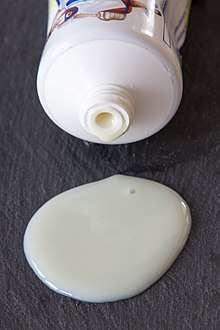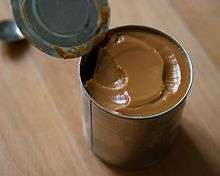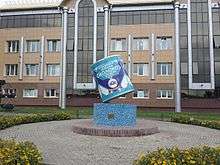Condensed milk
Condensed milk is cow's milk from which water has been removed (roughly 60% of it). It is most often found with sugar added, in the form of sweetened condensed milk (SCM), to the extent that the terms "condensed milk" and "sweetened condensed milk" are often used interchangeably today.[1] SCM is a very thick, sweet product, which when canned can last for years without refrigeration if not opened. The product is used in numerous dessert dishes in many countries.[2]

A related product is evaporated milk, which has undergone a lengthier preservation process because it is not sweetened. Evaporated milk is known in some countries as unsweetened condensed milk. Both products have a similar amount of water removed.[3]
History
According to the writings of Marco Polo, in the thirteenth century the Tatars were able to condense milk. Marco Polo reported that ten pounds (4.5 kg) of milk paste was carried by each man, who would subsequently mix the product with water. However, this probably refers to the soft Tatar curd (katyk), which can be made into a drink (ayran) by diluting it, and therefore refers to fermented, not fresh, milk concentrate.
Nicolas Appert condensed milk in France in 1820,[4] and Gail Borden, Jr., in the United States in 1853, in reaction to difficulties in storing milk for more than a few hours. Before this development, milk could be kept fresh for only a short while and was available only in the immediate vicinity of a lactating cow. While returning from a trip to England in 1851, Borden was devastated by the deaths of several children, apparently from poor milk obtained from shipboard cows. With less than a year of schooling and following a series of failures, both of his own and of others, Borden was inspired by the vacuum pan he had seen being used by Shakers to condense fruit juice and managed to reduce milk without scorching or curdling it.[5] Even then his first two factories failed[6] and only the third, built with new partner Jeremiah Milbank[7] in Wassaic, New York, produced a usable milk derivative that was long-lasting and needed no refrigeration.
Probably of equal importance for the future of milk production were Borden's requirements (the "Dairyman's Ten Commandments") for farmers who wanted to sell him raw milk: they were required to wash the cows' udders before milking, keep barns swept clean, and scald and dry their strainers morning and night. By 1858, Borden's milk, sold as Eagle Brand, had gained a reputation for purity, durability and economy.[8][9]
In 1864, Gail Borden's New York Condensed Milk Company constructed the New York Milk Condensery in Brewster, New York.[10] This was the largest and most advanced milk factory of its day and was Borden's first commercially successful plant. More than 200 dairy farmers supplied 20,000 gallons (76,000 litres) of milk daily to the Brewster plant as demand increased driven by the American Civil War.
The U.S. government ordered huge amounts of condensed milk as a field ration for Union soldiers during the war. This was an extraordinary field ration for the nineteenth century: a typical 10-oz (300-ml) can contain 1,300 calories (5440 kJ), 1 oz (28 g) each of protein and fat, and more than 7 oz (200 g) of carbohydrate.
Soldiers returning home from the war soon spread the word, and by the late 1860s condensed milk was a major product. The first Canadian condensery was built at Truro, Nova Scotia, in 1871.[11] In 1899, E. B. Stuart opened the first Pacific Coast Condensed Milk Company (later known as the Carnation Milk Products Company) plant in Kent, Washington. The condensed milk market developed into a bubble, with too many manufacturers chasing too little demand.[12] In 1911, Nestlé constructed the world's largest condensed milk plant in Dennington, Victoria, Australia.[13] By 1912, high stocks of condensed milk led to a drop in price and many condenseries went out of business.
In 1914, Otto F. Hunziker, head of Purdue University's dairy department, self-published Condensed Milk and Milk Powder: Prepared for the Use of Milk Condenseries, Dairy Students and Pure Food Departments. This text, along with the additional work of Hunziker and others involved with the American Dairy Science Association, standardized and improved condensery operations in the United States and internationally. Hunziker's book was republished in a seventh edition in October 2007 by Cartwright Press.[14]
The First World War regenerated interest in, and the market for, condensed milk, primarily due to its storage and transportation benefits. In the U.S. the higher price for raw milk paid by condenseries created significant problems for the cheese industry.[15]
Production
Raw milk is clarified[16] and standardised to a desired fat to solid-not-fat (SNF) ratio,[17] and is then heated to 85–90 °C (185–194 °F) for several seconds. This heating process destroys some microorganisms, decreases fat separation and inhibits oxidation. Some water is evaporated from the milk and sugar is added until a 9:11 (nearly half) ratio of sugar to (evaporated) milk is reached. The sugar extends the shelf life of sweetened condensed milk. Sucrose increases the liquid's osmotic pressure, which prevents microorganism growth. The sweetened evaporated milk is cooled and lactose crystallization is induced.[18]
Current use


Condensed milk is used in recipes for the Brazilian candy brigadeiro (where condensed milk is the main ingredient), key lime pie, caramel candies, and other desserts. Condensed milk and sweetened condensed milk is also sometimes used in combination with clotted cream to make fudge in certain countries such as the United Kingdom.
In parts of Asia and Europe, sweetened condensed milk is the preferred milk to be added to coffee or tea. Many countries in Southeast Asia, such as Vietnam and Cambodia, use condensed milk to flavor their hot or iced coffee. In Malaysia and Singapore, teh tarik is made from tea mixed with condensed milk, and condensed milk is an integral element in Hong Kong tea culture. In the Canary Islands, it is served as the bottom stripe in a glass of the local café cortado and, in Valencia, it is served as a café bombón.
Borden's Eagle Brand sweetened condensed milk has noted that ice cream could be made quite simply at home with their product, cream, and various simple flavorings, being ready to serve after as little as four hours.[19]
In New Orleans, sweetened condensed milk is commonly used as a topping on chocolate or similarly cream-flavored snowballs. In Scotland, it is mixed with sugar and butter then boiled to form a popular sweet candy called tablet or Swiss milk tablet, this recipe being very similar to another version of the Brazilian candy brigadeiro called branquinho. In some parts of the Southern United States, condensed milk is a key ingredient in lemon ice box pie, a sort of cream pie. In the Philippines, condensed milk is mixed with some evaporated milk and eggs, spooned into shallow metal containers over liquid caramelized sugar, and then steamed to make a stiffer and more filling version of crème caramel known as leche flan, also common in Brazil under the name pudim de leite.
In Mexico, sweetened condensed milk is one of the main ingredients of the cold cake dessert (the leading brand is "La Lechera", the local version of Swiss Milchmädchen by Nestlé), combined with evaporated milk, Marie biscuits, lemon juice, and tropical fruit. In Brazil, this recipe is also done exchanging fruit for puddings, most commonly vanilla and chocolate, known as pavê or torta de bolacha. It is also used to make homemade dulce de leche by baking it in an oven. In Brazil, this is done by baking the unopened can in a bain-marie, the result being doce de leite. In Britain and Ireland, the contents of a boiled can are used as the layer between the biscuit base and the banana and cream level in banoffee. In Latin American and Central American countries, condensed milk (along with evaporated milk and whole milk or canned cream) is used as a key ingredient in the tres leches cake dessert.
In Soviet Culture it was once common to boil a can of condensed milk in water for about three hours. The resulting product – a sweet semi-liquid substance which can be used as a cake icing or put between dry. It is essentially the same as dulce de leche. A similar product is called kajmak in Central Asia (although the original kaymak is a product similar to clotted cream).[20][21] In Russia its called varionaya sguschyonka (translates as "boiled condensed milk"). The Soviet tradition and kaymak are also known in Poland.
Substitutions
Condensed milk can be made from evaporated milk by mixing one measure of evaporated milk with one and a quarter measures of sugar in a saucepan, then heating and stirring the mixture until the sugar is completely dissolved, then cooling. It can also be made by simmering regular milk and sugar, until it is reduced by 60%.[22]
See also
References
- "Manufacture of Sweetened Condensed Milk". silverson.com. Silverson Machines. Retrieved 2019-10-17.
Sweetened condensed milk (SCM) is concentrated milk to which sugar has been added to act as a preservative. It differs from unsweetened evaporated milk, which is preserved by sterilization at high temperature after packaging. Typically, SCM contains around 8% fat, 45% sugar and 20% solids-non-fat. The finished product is mainly used in the manufacture of confectionery and chocolate.
- Pearlman, Ann; Bayer, Mary Beth (2010). The Christmas Cookie Cookbook: All the Rules and Delicious Recipes to Start Your Own Holiday Cookie Club. Simon and Schuster. pp. 197–. ISBN 978-1-4391-7693-1.
- "CARNATION FAQs". Nestlé, Carnation FAQs. Archived from the original on 9 February 2013. Retrieved 20 January 2016.
- Le livre de tous les ménages ou l'art de conserver. (Complete Book of Housework, or The Art of Preservation (in French), Paris, 1831, p. 82
- Becksvoort, Christian; Sheldon, John (1998-09-01). The Shaker Legacy: Perspectives on an Enduring Furniture Style. Newtown, CT: Taunton Press. p. 13. ISBN 978-1-56158-218-1.
- Borden's gravestone epitath is "I tried and failed, I tried again and again, and succeeded". Snodgrass, Mary Ellen (2004). Encyclopedia of Kitchen History. Routledge. p. 102. ISBN 978-1-135-45572-9.
- Frantz, Joe B. (1951) Gail Borden: Dairyman To A Nation. University of Oklahoma Press
- "Condensed Milk" (jpg). Nebraska State Journal. Lincoln, NE. 9 Sep 1907. p. 8. Retrieved 6 Aug 2017 – via Newspapers.com.
Prof. Hunziker of Purdue university gives the following interesting history of condensed milk: This year marks the 50th anniversary of the invention of the manufacture of condensed milk by Gail Borden. The first factory in the world was erected, completed and operated by Gail Borden in Connecticut in 1856. The beginning was small, the process crude and the product imperfect, and it was not until the strenuous years of the war of secession that its value and usefulness as a commodity became fully recognized.

- Dudlicek, James (March 2008). "Renewed focus: a decade after its formation, DFA adjusts its outlook to secure the future for its member owners". Dairy Foods. Retrieved 2008-06-26.
- "New York Milk Condensery, Borden's Milk". Southeast Museum. Archived from the original on 2008-06-27. Retrieved 2008-06-26.
- Bélanger, Claude (2005). "Dairying in Canada". L’Encyclopédie de l’histoire du Québec / The Quebec History Encyclopedia. Marianopolis College. Retrieved 2008-06-26.
- "Condensed Milk" (jpg). Nebraska State Journal. Lincoln, NE. 9 Sep 1907. p. 8. Retrieved 6 Aug 2017 – via Newspapers.com.
According to the United States census of 1900, in that year there were over fifty factories in the United States. The increase of condensories during the last five years has been so rapid that it is safe to put the total number of factories today at 100 in this country alone. The census report of 1903 estimates that about 1,000,000,000 pounds of milk were received at our condensories with an aggregate output of 250,000,000 pounds of condensed milk in that year.

- "Historical timeline" (PDF). Société des Produits Nestlé SA. Archived from the original (PDF) on September 5, 2007. Retrieved 2008-06-26.
1911 Dennington Condensed Milk factory built (largest in the world during the war).
- Hunziker, O. F. (1914) [1914]. Condensed milk and milk powder: prepared for the use of milk condenseries, dairy students and pure food departments. LaGrange, IL. ISBN 978-1-4067-8266-0. 2nd Ed. (LaGrange, IL: 1918), (LaGrange, IL: 1920), alternative 3rd Ed
- Pauly, William H (1918). "Condensery competition with factories". Proceedings of the Wisconsin Cheese Makers' Association Annual Conventions 1916-17-18: 155–165. Retrieved 2008-06-26.
- "Clarification | Food Science". www.uoguelph.ca. Retrieved 2017-10-09.
- Sharma, Prateek; Patel, Hasmukh; Patel, Ashok (2015). "13. Evaporated and Sweetened Condensed Milks". In Chandan, Ramesh C.; Kilara, Arun; Shah, Nagendra P. (eds.). Dairy Processing and Quality Assurance. John Wiley & Sons, Ltd. pp. 310–332. doi:10.1002/9781118810279.ch13. ISBN 9781118810279.
- Goff, Doug (1995). "Concentrated and Dried Dairy Products". Dairy Science and Technology Education Series. University of Guelph, Canada. Archived from the original on 2008-06-11. Retrieved 2008-06-26.
- Walker, Judy, Make New Orleans flavored ice cream without a fancy machine, Nola.com, August 5, 2010
- "Why Russians boil sweetened condensed milk". www.rbth.com. Retrieved 2020-01-22.
- "10 yummies that all Soviet children adored | Educa Russian Language Center". educalanguageschool.com. 2017-11-16. Retrieved 2020-01-22.
- "Substitute for Condensed Milk". www.Ochef.com. Food News Service. Retrieved 2010-11-28.
External links

